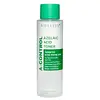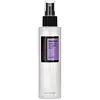What's inside
What's inside
 Key Ingredients
Key Ingredients

 Benefits
Benefits

 Concerns
Concerns

 Ingredients Side-by-side
Ingredients Side-by-side

Melaleuca Alternifolia Leaf Water
AntimicrobialButylene Glycol
Humectant1,2-Hexanediol
Skin ConditioningGlycolic Acid
BufferingCitric Acid
BufferingNiacinamide
SmoothingDipropylene Glycol
HumectantGlycerin
HumectantWater
Skin ConditioningLactic Acid
BufferingSnail Secretion Filtrate
Skin ConditioningAzelaic Acid
BufferingSalicylic Acid
MaskingPropanediol
SolventPolyglyceryl-10 Laurate
Skin ConditioningEthylhexylglycerin
Skin ConditioningDisodium EDTA
Capryloyl Salicylic Acid
ExfoliatingGluconolactone
Skin ConditioningDecyl Glucoside
CleansingSodium Hyaluronate
HumectantSalix Alba Bark Extract
AstringentCladosiphon Okamuranus Extract
Skin ConditioningCentella Asiatica Leaf Extract
Skin ConditioningCamellia Sinensis Leaf Extract
AntimicrobialCoffea Arabica Seed Extract
MaskingCitrus Aurantium Bergamia Leaf Extract
AstringentPinus Densiflora Leaf Extract
AntimicrobialHyaluronic Acid
HumectantHydrolyzed Hyaluronic Acid
HumectantHydroxypropyltrimonium Hyaluronate
Potassium Hyaluronate
Skin ConditioningSodium Hyaluronate Crosspolymer
HumectantSodium Acetylated Hyaluronate
HumectantMelaleuca Alternifolia Leaf Water, Butylene Glycol, 1,2-Hexanediol, Glycolic Acid, Citric Acid, Niacinamide, Dipropylene Glycol, Glycerin, Water, Lactic Acid, Snail Secretion Filtrate, Azelaic Acid, Salicylic Acid, Propanediol, Polyglyceryl-10 Laurate, Ethylhexylglycerin, Disodium EDTA, Capryloyl Salicylic Acid, Gluconolactone, Decyl Glucoside, Sodium Hyaluronate, Salix Alba Bark Extract, Cladosiphon Okamuranus Extract, Centella Asiatica Leaf Extract, Camellia Sinensis Leaf Extract, Coffea Arabica Seed Extract, Citrus Aurantium Bergamia Leaf Extract, Pinus Densiflora Leaf Extract, Hyaluronic Acid, Hydrolyzed Hyaluronic Acid, Hydroxypropyltrimonium Hyaluronate, Potassium Hyaluronate, Sodium Hyaluronate Crosspolymer, Sodium Acetylated Hyaluronate
 Reviews
Reviews

Ingredients Explained
These ingredients are found in both products.
Ingredients higher up in an ingredient list are typically present in a larger amount.
1,2-Hexanediol is a synthetic liquid and another multi-functional powerhouse.
It is a:
- Humectant, drawing moisture into the skin
- Emollient, helping to soften skin
- Solvent, dispersing and stabilizing formulas
- Preservative booster, enhancing the antimicrobial activity of other preservatives
Butylene Glycol (or BG) is used within cosmetic products for a few different reasons:
Overall, Butylene Glycol is a safe and well-rounded ingredient that works well with other ingredients.
Though this ingredient works well with most skin types, some people with sensitive skin may experience a reaction such as allergic rashes, closed comedones, or itchiness.
Learn more about Butylene GlycolGlycolic Acid is arguably the most famous alpha hydroxy acid (AHA) with tons of research backing its benefits.
It is found naturally in sugar cane but the form used in skincare is usually synthetic for purity and stability.
Glycolic acid removes the top layer of dead skin cells to allow newer and fresher ones to emerge.
AHAs work by breaking down the structural “glue” that holds old skin cells in place. When that buildup is gone, your skin can renew itself more efficiently.
Research also shows glycolic acid stimulates collagen production, helping to firm and thicken the skin over time. This is one of its biggest advantages over other AHAs.
Overall, glycolic acid helps with:
Fun fact: Glycolic acid boosts skin hydration by helping it produce molecules that increase hyaluronic acid naturally.
To work best, glycolic acid products should have a pH between 3-4 (that’s where exfoliation is most effective but still gentle on skin).
The pH and concentration of a product are key to its effectiveness:
It is normal to feel a slight stinging sensation when using glycolic acid. This usually fades as your skin adjusts.
Because glycolic acid has the smallest molecular size in the AHA family, it can penetrate deeper, which enhances its effectiveness but also makes it more likely to irritate sensitive skin.
If your skin is very sensitive or prone to rosacea, glycolic acid may be too strong; in that case, try milder options like lactic acid or a PHA instead.
Recent studies suggest glycolic acid might even help protect against UV damage. But don’t skip sunscreen! Freshly exfoliated skin is more sensitive to the sun.
Glycolic acid is a skincare superstar. It smooths, brightens, hydrates, and firms the skin. Unless you’re highly sensitive, it’s well worth adding to your routine.
Read more about some other popular AHA's here:
Learn more about Glycolic AcidWater. It's the most common cosmetic ingredient of all. You'll usually see it at the top of ingredient lists, meaning that it makes up the largest part of the product.
So why is it so popular? Water most often acts as a solvent - this means that it helps dissolve other ingredients into the formulation.
You'll also recognize water as that liquid we all need to stay alive. If you see this, drink a glass of water. Stay hydrated!
Learn more about Water